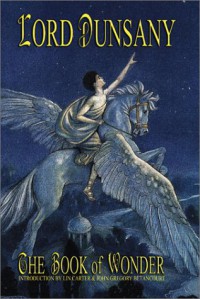 Geek that I am I actually read this to prepare for the Tolkien Professor’s Faerie & Fantasy podcast seminar that covers the book. I am rather conflicted about Dunsany in general and this book in particular. After finishing the first half I found that _The Book of Wonder_ more or less confirmed for me my initial impressions of Dunsany gathered when I first read _The Hashish Man and Other Stories_ many years ago. Namely that while Dunsany is an excellent prose stylist and creator of many arresting images in his short tales there is still something missing. The missing elements are pretty major: plot and character. Of the first few stories only “The Bride of the Man-Horse” and “Miss Cubbidge and the Dragon of Romance” struck me with their images and ideas in a meaningful way, the others came across more as fragments that may have presented some interesting imagery, but they were not enough to really maintain my interest. As I continued on with the second half of the book, however, I started to feel that maybe these arresting images were enough and the stories seemed to gather more steam.
Geek that I am I actually read this to prepare for the Tolkien Professor’s Faerie & Fantasy podcast seminar that covers the book. I am rather conflicted about Dunsany in general and this book in particular. After finishing the first half I found that _The Book of Wonder_ more or less confirmed for me my initial impressions of Dunsany gathered when I first read _The Hashish Man and Other Stories_ many years ago. Namely that while Dunsany is an excellent prose stylist and creator of many arresting images in his short tales there is still something missing. The missing elements are pretty major: plot and character. Of the first few stories only “The Bride of the Man-Horse” and “Miss Cubbidge and the Dragon of Romance” struck me with their images and ideas in a meaningful way, the others came across more as fragments that may have presented some interesting imagery, but they were not enough to really maintain my interest. As I continued on with the second half of the book, however, I started to feel that maybe these arresting images were enough and the stories seemed to gather more steam.In many ways Dunsany, in his short tales at least, has always been for me less a writer and more a painter of prose pictures. Many of his tales from _The Book of Wonder_ are probably best taken in conjunction with the lush and beautiful drawings of them made by Sydney Sime since it often felt to me like they didn’t really have a beginning or an end, though they generally gave me a vivid picture of some arresting image or idea. Whether this was the gloomy house of the doomed Sphinx, the majestic and exhilarating ride of the centaur Shepperalk, or the final hopeless venture of the thief Thangobrid we are given by Dunsany what amounts to a painting in words, but it isn’t a story (or it is only part of one). When a writer like Tolkien makes an offhand reference to some other place or person in his tales it carries with it the weight of a true tale and the depth of history, we know that it isn’t merely a colourful name inserted for flavour…with Dunsany I do not always get this impression.
The comparison to pictures is instructive in that it points out both Dunsany’s strengths and his weaknesses. He is a vivid writer of poetic prose, able to evoke emotions and an almost painful nostalgia for the magical and the dreamlike, a yearning for what has been, or soon will be, lost. On the other hand he can be, at his worst, two dimensional. I think this is why I have always preferred Dunsany’s longer works such as _The Charwoman’s Shadow_ or _The King of Elfland’s Daughter_ to his shorter ones. In these longer works he is constrained by the demands of his form to have at least the semblance of plot and character and even the minimal skeleton he builds in this regard is enough to carry his lush prose and beautiful images beyond being mere pictures. They now have context that makes the heartsick longing meaningful.
And yet…and yet. As I finished this volume I kept coming back to the ability of Dunsany as a prose stylist. At first I was content with the thought that I should simply treat my visits to his work as a trip to a fantastic museum where I would be treated to some startling paintings; or better yet a sampling from the amuses bouches of a master confectioner that may give me food for thought and a sip from an inexplicable draught, but for real nourishment I would have to look elsewhere. As I finished the volume, however, I felt that I had to perhaps re-evaluate this position. Tales like “The Hoard of the Gibbelins”, “How Nuth would have Practiced his Art upon the Gnoles”, “How One Came, as was Foretold, to the City of Never”, and especially the somewhat thematically twinned tales “The Coronation of Mr. Thomas Shap“ and “The Wonderful Window” either seemed to come together more coherently as stories or had such well expressed ideas and images of wonder that I had to admit that Dunsany had achieved something meaningful here.
I still think that if I want lush prose and vivid, weird imagery I am more likely to go to Clark Ashton Smith, who married these strengths to more elements of plot and character than I am likely to find in Dunsany, but I am starting to see that perhaps I am merely expecting something from Dunsany’s tales that he never intended to deliver, and that his contribution to the genre as a founder and necessary first step can’t be denied.






